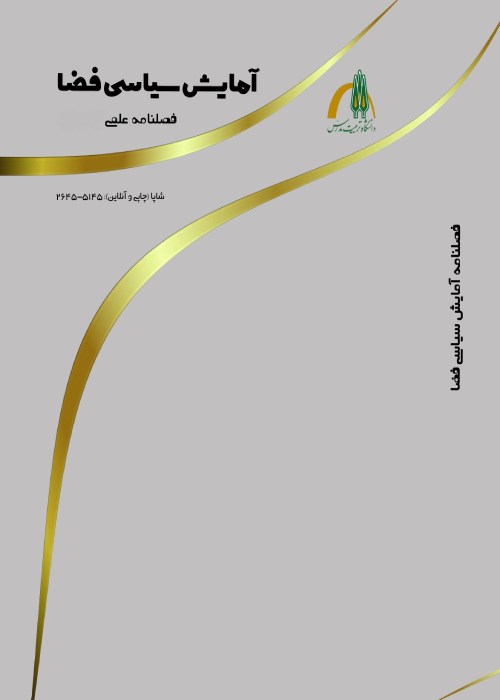Explaining the Hydropolitical Implications of Climate Change in Iran: Case Study of Zayandehrud Basin
The land of Iran is located in a belt of dry and desert areas of the earth, which suffers the most unfavorable effects from climate change. Climate change is evident in the Zayandehrud basin, and its effects are evident in the decrease of rainfall and increase in temperature in recent years, as well as the continuation of droughts in the Zayandehrud watershed. With the reduction of river water flow, the allocation of water to the agricultural and environmental sectors in the middle and downstream parts has faced a problem. The need for water in this basin is high, so that during these years, the effort to obtain water in the Zayandehrud basin has entered a new arena in the form of tension, conflict, protests, and social unrest. One of the most important consequences of climate change is that it forces governments to plan inter-basin transfers. As a result of the water transfer policies without taking into account the religious rights and the environmental rights of the Zayandehrud bed and the Gavkhoni wetland, many social differences between the provinces have intensified.
In terms of its purpose, the current research is an applied research that considering the historical, geographical, economic and political importance of the area, identifies the dimensions and effects of climate change in the Zayandehrud watershed and explains how climate change can increase crisis and tension in the watershed. This can be a useful guide for planners and decision makers in the field. In terms of method and nature, this research is descriptive-analytic, and the method of data gathering procedure is based on library sources, including books, magazines, and databases.
The turning of snow into rain at the source of the Zayandehrud and the increase in evaporation has led to the reduction of lands in the downstream part of the river, so that the area of "agricultural" and "pasture" lands has decreased in the middle and downstream parts. The number of wells has increased dramatically in recent years. The number of wells in the middle and downstream parts has increased significantly in this period, the average depth of the wells in the basin has increased by 4.8 meters, which is 6.65 meters in the upstream part, 5.55 meters in the middle part, and 28.28 meters in the downstream part. An average of 6 meters has been added to the depth of the wells. The increase in inter-provincial tensions, of which prominent examples were observed between Khuzestan, Isfahan and Chaharmahal Bakhtiari provinces in recent years, is one of the most important political consequences of climate change, which forces governments to plan inter-basin transfers. Isfahan farmers are the most important group protesting the critical water situation in this basin. One of the most important concerns of the people of the region and the most important cause of strikes and conflicts in recent years is the reduction of water resources and the reduction of agricultural activity. In recent years, the farmers of the region have expressed their protests in various ways, such as breaking and breaking water pipes, strikes, demonstrations and blocking the road with tractors, referring to the province and other ways. Public tension and protests regarding water supply and optimal water management for the residents of Zayandehrud Basin are not limited to the residents and beneficiaries of Zayandehrud Watershed. Hydro-political issues of the Behesht Abad water transfer project in the upper part of the Karun Basin, which has been the cause of local, regional and even national disputes between people and officials at the source and destination. This has caused social and political differences between the residents and beneficiaries of the upstream watersheds and the mentioned watersheds, and due to the ethnic differences of the watersheds, this issue has turned into an internal hydro-political crisis that has created gaps between ethnic groups. Climate change has hit the agriculture sector the most. Also, the first procedural consequence is the increase in the amount of unemployment and the immigration crisis. Immigration has led to the dispersal of kinship relations and the loss of solidarity, ethnic cohesion, and the increase of individualism and isolation, and as a result marginalization and drug addiction. The drying of Zayandehroud riverbed due to climate change has caused numerous cracks and subsidence in different areas of the watershed in Isfahan province. The depth of these cracks is very deep and in some cases they have a depth of more than 10 meters. Cracks have caused serious damages to roads and agricultural land.
Climate change in the Zayandehrud basin is one of the factors that threaten the water resources in the basin. The climate change and decrease in rainfall and the expansion of agriculture and water-bearing industries has led to the destruction of nature and the geographical space and the lowering of the underground water level and even the transformation of permanent rivers into seasonal and seasonal into casual and dry rivers, and to compensate for this situation, the water transfer policy. This approach has caused political and security tensions in this region. Among the hydro-political issues of the water transfer projects in the mentioned catchment basin and its negative social-political consequences can be the intensification of local and regional conflicts and divergences, jeopardizing local and regional security, political activism of people and officials, ethnic diversity and political and regional sensitivities. One of the factors that play a basic role in creating negative political activism caused by water transfer is the strengthening of political regionalism, which itself is caused by weak management policies. This leads to the formulation of "negative hydro-politics" on a national and regional scale, and in turn has negative effects on local, regional and even national security issues.
- حق عضویت دریافتی صرف حمایت از نشریات عضو و نگهداری، تکمیل و توسعه مگیران میشود.
- پرداخت حق اشتراک و دانلود مقالات اجازه بازنشر آن در سایر رسانههای چاپی و دیجیتال را به کاربر نمیدهد.


